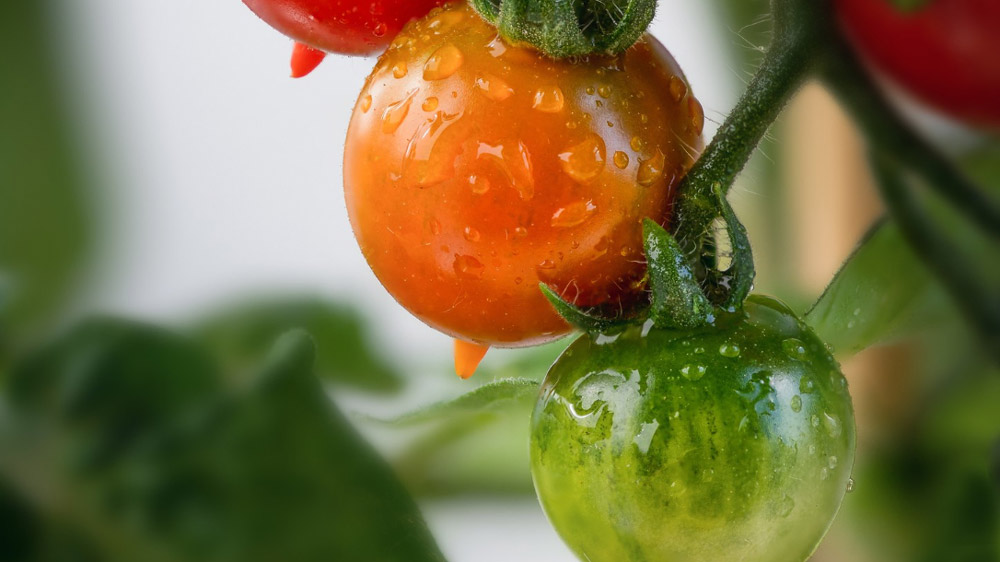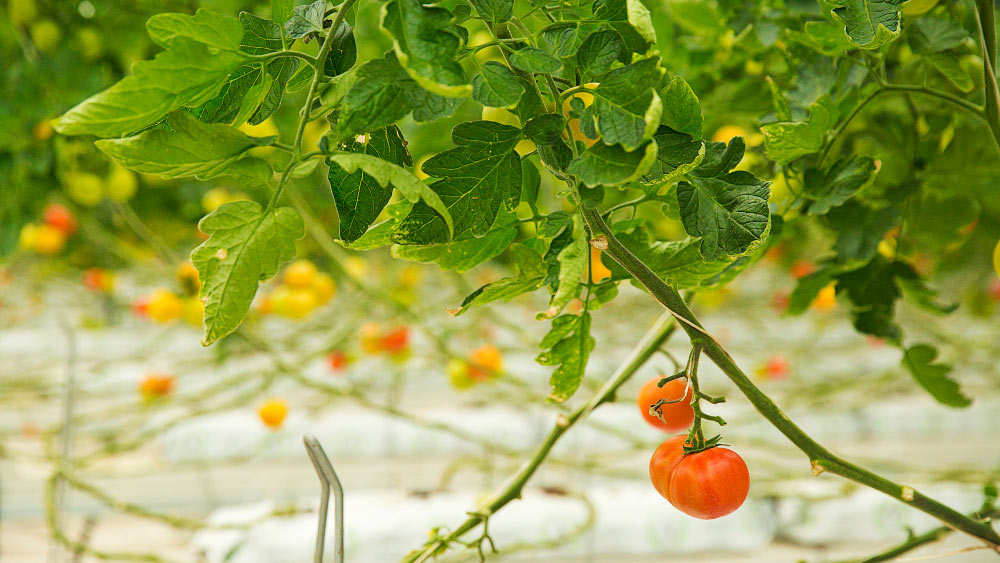The pH Perfection for Hydroponic Tomato Success

Are you loving that hydroponic tomato harvest?
The Sun Gold cherries develop their beautiful color with the help of a special process called pH balance. This process makes them taste amazing and look irresistible to eat.
Did you know balancing acid and alkaline levels in your nutrient water can help you grow amazing tomatoes?
Even though pH charts in science class may seem boring, they hold the key to unlocking the secrets of healthy tomato plants. Remember, a balanced pH level in your nutrient water is crucial for growing A+ tomatoes.
Keep things too acidic or basic for those finicky roots, and your plants paddle upstream, battling to sip the nutrients from the soil they need to pop.
Miss the 5.5-6.5 pH sweet spot, and kiss scrumptious summer slicing goodbye!
From testing trouble signs from pH imbalance to pH-adjusting tricks using lemon or Epsom salt, let’s master the science of balancing big, beautiful hydroponic tomatoes with bumper harvests.
I’ll make a complex topic easy to dial in.
pH Balance and Its Importance for Hydroponic Tomatoes
The pH helps your plants absorb nutrients from water. It’s a scale that measures how acidic or basic the water is.
If the pH isn’t correct, your tomato plants might not be able to get the food they need, even if it’s right there in the water!
Let’s stop guessing and figure out the exact pH using these pH meters for hydroponics.
Why pH Matters for Your Hydroponic Tomatoes
When the pH level is off, your tomatoes can look weak, discolored, or just not as yummy as they should be. It’s all about creating the perfect environment for them to thrive.
Ideal pH Range for Hydroponic Tomatoes
So, what’s the magic pH number for hydroponic tomatoes?
Aim for a pH range between 5.5 and 6.5. This range is the sweet spot where tomatoes can easily absorb all the necessary nutrients. It’s like setting the table for a big feast – your tomatoes will love it!
Impact of pH Imbalance
If the pH drifts too high or too low, your tomatoes might look wilted and weak. They could get nutrient deficiencies, meaning they’re not getting enough of the good stuff they need to grow strong and healthy.
You might see leaves turning yellow or brown, or the fruits might not develop properly. You will see almost the same impacts on other vegetables suitable for hydroponic farming.
Signs of pH Imbalance in Tomato Plants
Yellowing Leaves: A Telltale Sign
Have you noticed the leaves of your hydroponic tomatoes turning yellow? That’s often the first sign that something’s up with the pH level.
When the pH is off, your plants struggle to absorb nutrients, which shows up as yellow leaves. It’s like your plants are waving a little yellow flag saying, “Help, I’m not getting what I need!”

Stunted Growth: When Tomatoes Don’t Grow Up
Another clue that your pH might be out of whack is when your tomato plants just stop growing.
They’re like kids who don’t get the right food and don’t grow as tall as they should. If your plants are smaller than expected or the growth has slowed down, it’s time to check that pH.
Blossom End Rot: A Sad Tomato Tale
Have you ever seen a tomato with a dark, rotten spot at the bottom? That’s called blossom end rot, and it can happen when pH issues block calcium absorption.
It seems like the plant can’t get to the calcium “milk” it needs for strong bones – or, in this case, strong fruits.
Leaf Curling: More Than Just a Quirk
Leaves curling up or down can be a quirky way your plants tell you they’re not happy with the pH. The leaves are trying to roll themselves up to hide from the problem. But don’t worry; they’ll uncurl with the correct pH adjustment and return to normal.
Poor Fruit Development: When Tomatoes Don’t Shine
Tomatoes that don’t look right – maybe small, misshapen, or just not as vibrant – could suffer from pH imbalance.
Wilting: A Sign of Stress
If your tomato plants are wilting, it’s a big sign they’re stressed out, possibly due to pH issues. Imagine being thirsty on a hot day – that’s how your plants feel when they can’t absorb water and nutrients properly because of the wrong pH.
Dark Spots on Leaves: Not Just a Beauty Mark
Dark spots on the leaves are blemishes that show up when your plants are struggling. These spots can mean your plants miss crucial nutrients because the pH stops them from eating properly.
Adjusting the pH Level in a Hydroponic System
Adjusting the pH level starts with detecting the pH level in the water. And testing your hydroponic system’s pH is as simple as using a thermometer.
You can get a digital pH meter or pH testing test strips – both are great tools for this mission. Dip your chosen instrument into the water and check the reading.
Remember, for tomatoes, you’re aiming for a pH sweet spot between 5.5 and 6.5. If your reading falls outside this range, it’s time to take action.

Lowering the pH
If your reading is above 6.5, you’ll need to lower the pH. You can use a commercial pH-down solution, which typically contains phosphoric acid, citric acid, or sulfuric acid.
Add the solution in small increments, then stir your nutrient solution thoroughly. It’s like adding salt to a dish – you can always add more, but you can’t take it out once it’s in.
Raising the pH
Conversely, if your pH is below 5.5, you’ll need to raise it. A pH-up solution, usually potassium hydroxide or sodium hydroxide, will do the trick.
Again, add this slowly and mix well. Think of it as adjusting the seasoning in your cooking, adding gradually until it’s just right.
Re-testing and Adjusting
After making adjustments, wait about an hour before re-testing the pH. This waiting period allows the solution to integrate the changes fully. It’s like letting a stew simmer to develop flavors.
Repeat the adjustment process if the pH isn’t in the ideal range.
Why does pH change in hydroponics?
The pH level in hydroponic systems can change due to several factors, each playing a role in the overall chemistry of the nutrient solution.
Understanding these factors is crucial for maintaining an optimal plant-growing environment. Here’s why pH levels can fluctuate in hydroponics:
- Nutrient Uptake: As plants absorb nutrients from the solution, they can alter their pH. Different nutrients affect pH in various ways. For example, when plants uptake more nitrogen in the form of nitrates, they often release hydroxide ions into the solution, which can increase the pH. Conversely, the uptake of other nutrients might lower the pH.
- Water Quality: The source water in your hydroponic system can significantly impact pH levels. Tap or natural water sources often contain dissolved minerals and gases that raise or lower the pH. For instance, water with a high carbonate content (hard water) tends to have a higher pH.
- Nutrient Solution Concentration: Over time, as plants consume nutrients, the concentration of the remaining nutrients in the solution can change, which can affect the pH. This is because the solution’s balance between acidic and basic ions shifts as plants absorb different nutrients at different rates.
- Microbial Activity: Beneficial bacteria and other microorganisms in the hydroponic system can produce acidic or basic waste products, influencing the pH. The activity of these microbes can be affected by factors like temperature, oxygen levels, and the organic matter in the system.
- Evaporation and Oxygenation: Evaporation can concentrate the nutrients and minerals in the solution, potentially leading to a pH change. Additionally, aeration or oxygenation of the water can lead to the loss of carbon dioxide, which can increase pH since carbon dioxide in water forms a weak acid.
- Chemical Reactions: Certain chemical reactions within the nutrient solution, such as those involving dissolved oxygen or carbon dioxide from the air, can alter the pH. For example, carbon dioxide dissolves in water and forms carbonic acid, which lowers the pH.
- Addition of Supplements: If you add supplements, pH adjusters, or additional nutrients to your hydroponic system, these can directly alter the pH. It’s essential to add these carefully and in the correct quantities to avoid sudden pH swings.
- Environmental Factors: Temperature and light can also influence the pH of your hydroponic solution. Temperature changes can affect the solubility and reaction rates of chemicals in the water, thereby impacting the pH.
Nutrient Requirements for Hydroponic Tomatoes
Growing tomatoes hydroponically is like conducting a symphony – every nutrient plays a crucial role. Macronutrients are the heavy hitters, required in larger quantities.
These include elements like nitrogen (N), phosphorus (P), and potassium (K), often referred to as N-P-K.
They’re essential for growth, root development, and fruit production. But let’s not forget the micronutrients – like iron, manganese, zinc, copper, molybdenum, boron, and chlorine.
Though needed in smaller amounts, they’re like the spices in a dish, vital for your tomatoes’ overall health and flavor.

Balancing Act: Ensuring Proper Nutrient Ratios
Getting the right balance of these nutrients is critical.
For instance, nitrogen is crucial for leaf and stem growth, but too much can lead to lush foliage at the expense of fruit.
Phosphorus supports strong root development and flowering, while potassium is essential for overall plant health and fruit quality.
The Role of Nutrient Solutions
In hydroponics, your nutrient solution is your plant’s lifeline. There are ready-made solutions available, or you can mix your own.
The concentration of nutrients in your solution will change as your plants grow. Seedlings have different needs compared to flowering plants.
Adjusting for Different Growth Stages
As your tomatoes move from seedlings to mature plants, their nutrient needs change.
In the vegetative stage, they need more nitrogen for leaf growth. But as they enter the flowering and fruiting stages, phosphorus and potassium become more important.
The Importance of Water Quality
Remember, the quality of your water can affect nutrient availability. Hard water or water with high mineral content might need adjustments to your nutrient solution.
Final Words
Mastering the pH balance in hydroponic tomato cultivation is crucial for success. It’s not just about providing your plants with the proper nutrients; it’s about ensuring they are accessible in an environment conducive to growth.
Achieving the ideal conditions for your hydroponic tomatoes to thrive requires close attention to their pH levels. You can strike the perfect balance by carefully monitoring and making necessary adjustments. Remember that this balance is delicate, but with care and focus, you can attain it.
Hydroponics is part science and part patience, and getting the pH levels right is a real badge of honor for any dedicated gardener. So, let’s get growing!
Happy growing, and may your hydroponic tomatoes thrive in their perfectly balanced environment!